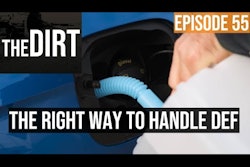
Do you think extended warranties or protection plans are a waste of time and money?
For many consumer goods, the answer to that is often yes. Frequently, extended warranties are too focused as profit centers for the sellers rather than optimized for manufacturers, dealers and customers. But with the correct data and risk-management structure, extended warranties can be an indispensable tool when purchasing, owning and operating heavy equipment.
Considering extended protection as an investment in their equipment, manufacturers set a clear strategy to achieve their risk-management goals by providing the suitable machine at the right price and ensuring the equipment is productive and reliable. However, technology has changed the game, and there are new factors that customers consider. These evolving expectations concern the total cost of ownership. They include the connectivity of these machines to manage your entire fleet better and provide more value to you and your operations over time.
These new expectations demand new solutions. An extended protection plan is a way to manage costs for your equipment, but it should also fit as part of the product life cycle. After all, your equipment is an asset. Some key questions to ask yourself when considering your extended protection options:
- What is my current process for maintenance and repairs?
- Is warranty and risk management on the radar of my senior leadership?
- What is my company’s appetite for financial risk?
- Who is backing the program?
Conducting a Product Life-Cycle Maturity Assessment can begin to answer these questions. The assessment takes a deep dive from new machine purchase through a rebuild and final disposition, including all costs along the journey. It is no secret that capital equipment requires keen management and maintenance through the years. A maturity assessment will help you understand the costs and manage this over the product life cycle.
 AEMP; Equipment World graphic
AEMP; Equipment World graphic
Extended warranty risk-management strategy
There are three primary ways to manage risk for an extended service contract:
- OEM Backed – Original equipment manufacturers are typically best positioned to manage the risks associated with their products. All manufacturers have a standard warranty and the teams to support the claims and administration. Adding an extended warranty or service contract is not a significant challenge. Picking a solution backed and underwritten by the manufacturer is typically the best option for equipment owners. The OEM wants to build loyalty with its customers, both through its dealers and through providing parts and service. This OEM-backed solution cost structure is highly efficient. Keeping the failure data within the organization and providing valuable insights that drive quality improvements back to the manufacturer is also best for the OEM. Dealers are already using the warranty platform, so administration at the dealership is seamless. Frequently, OEMs will offer marketing programs that support extended warranties, which are also a significant advantage for the contractor.
- Third-Party – Buying insurance is the proper decision for many types of risk. For extended warranty, it is not always the best value for the end-user equipment owner. The high frictional costs for claims administrators, underwriters, brokers and commissions paid to dealers reduce the funds available to pay the actual claims. Third-party extended service contracts are not likely to provide the best value for equipment owners.
- Self-insured – When considering all options to manage extended service contracts’ risks, retaining the risk on the balance sheet or in a captive insurance company is viable. There is a structured approach to evaluating self-insurance. One must consider their risk tolerance, balance-sheet strength, service, repair capabilities, and historical failure and repair history. Suppose your dealer is self-insuring extended service contracts. In that case, that is an excellent option for equipment owners, indicating the dealer stands behind their products. They have also likely done their homework and understand the risk and how to manage it.
 AEMP; Equipment World graphic
AEMP; Equipment World graphic
Regardless of the method, an extended warranty protects any machine at any point in the product life cycle. Whether construction, agriculture, or forestry equipment, each product family has an industry-standard extended warranty that addresses specific customer needs, such as time, deductibles and portability.
Weighing the costs & benefits of extended warranty
Understanding these factors, let’s break down the cost and benefits of an extended warranty. Machines and parts fail, period. It goes with the territory. The right risk-management strategy, however, can help to forecast these failures and build confidence in the process along the way. Most machines provide live data feeds and are connected, all of which make it easier to anticipate and manage both planned and unplanned downtime. While it is easier to manage the performance of new machines, extended-warranty options can also apply to rebuilt machines and improve your overall fleet management.
Understanding the underlying repair costs is essential. If you are managing repairs yourself, track the time it takes, including downtime. Similarly, ask to see prices of repairs and labor if you use a partner. This data will give you a better picture of use patterns and whether there may be an underlying issue driving claims. It will also help you understand the costs of ownership and how mature your product life-cycle strategy is.
However, you can’t simply weigh the dollars spent on an extended warranty versus the money you get back in claims to understand the true value. You must consider the cost as part of your overall risk management strategy.
Competitive advantage
A key benefit of a long extended-protection program is shifting an equipment manager’s variable costs to fixed costs. But long-term warranties can provide a return on investment for all users. OEMs like longer-term warranties because they give them more data on the quality and reliability of machines that they can relay to dealers. Knowing that trained mechanics will handle repairs quickly and efficiently lowers overall owning and operating costs and builds loyalty. And dealers benefit from increased revenue from parts and service, confidence in their equipment, and higher resale values because of the rich data set generated.
Your equipment fleet is an asset, and you should invest in taking care of it. An extended warranty isn’t a waste of time or money, but a wasted opportunity if not structured efficiently, correctly priced and well-positioned.
Matt Haas is the manager of Construction & Forestry Extended Warranty at John Deere. Jimmy Bynum is the president of Garde Solutions, which partners with manufacturers and distributors to restructure and optimize their warranty programs.











